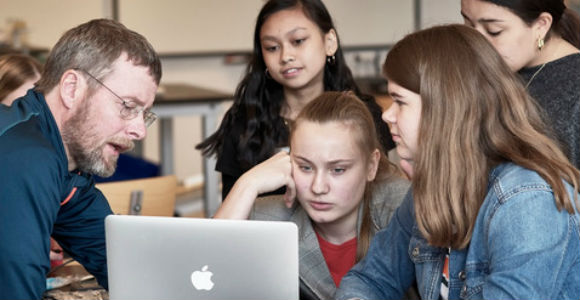
New project aims to integrate the language of maths
Maths is an important, yet isolated, subject in primary school, says grant recipient who wants to bridge the gap between maths and the rest of the natural sciences with his new project, supported by the Novo Nordisk Foundation.
”How can I actually use maths in my everyday life?”
This is a question asked by many young people, as they have a hard time seeing which role maths could play in their lives.

A sizable new development project aims to help bridge the gap between maths and the rest of the STEM subjects (Science, Technology, Engineering and Maths).
Maths should be involved everywhere
Maths is going to be the shared language (using mathematical terms in relation to scientific and technological phenomena) which all children will speak across all natural science subjects from when they are in day care until they leave upper secondary school. This is crucial, as it is impossible to avoid maths if you wish to learn the other subjects.
– Matdh is an isolated subject which needs to be integrated more into other natural science subjects in Danish schools by clarifying what exactly STEM is. Everyone thinks that maths is important, but they can’t seem to explain why. We need to change that, says Claus Michelsen, professor in the didactics of mathematics and natural sciences at the Department of Mathematics and Computer Science.
Claus Michelsen has received a grant of almost DKK 6 million from the Novo Nordisk Foundation to realise his project.
The project has two goals
Claus Michelsen’s project has two goals. Firstly, he wants to establish a concrete STEM didactic – a shared language for all STEM subjects which makes it easier to combine and integrate them into each other.
An example would be using mathd to understand biology or solve problems in engineering.
– We are addressing a specific problem with this project. The other subjects do not currently integrate maths, even though maths is an ideal language for understanding these subjects. That is why we want to create a shared language which helps teachers clarify the role of maths and explain what STEM is all about, says Claus Michelsen.
Tools to be developed in collaboration with teachers
The second part of the project is creating specific tools for teachers to use in their lessons. The tools will integrate maths into the other STEM subjects, so they need to be accessible and useful for teachers who are going to teach technology, engineering or science.
Claus Michelsen will develop these tools in collaboration with his own university team as well as kindergarten teachers, primary school teachers and upper secondary school teachers. 300 teachers and 5,000 students will be participating in the so-called LabSTEM project.
– We will, for example, be making teaching material for kindergarten and pre-preparatory teachers who are teaching about the term ‘energy’. Collaborating with the teachers, we are developing the material so that it integrates maths in the understanding of ‘energy’. Afterwards, the material will be made accessible for teachers all over Denmark, explains Claus Michelsen.
The project could become even bigger
The participating kindergarten teachers, primary school teachers and upper secondary school teachers will meet once a month. In different teams, the participants will define a STEM related problem and develop a lesson plan to deal with the problem. Subsequently, the lesson plan will be tested in practice and finally adjusted.
The lesson plans will be qualified by researchers and made accessible for others.
– We have a goal of creating cohesion right from day care to upper secondary education. Here, students will learn the mathematical language and which role it plays in the rest of the STEM subjects. This cohesion needs to be supported by several tools for teachers to use, says Claus Michelsen.
The LabSTEM project, Laboratory for integrated STEM education and learning, is one of a total of 16 projects which have received funding from the Novo Nordisk Foundation’s programme of maths in natural science and technology.
Meet the researcher
Claus Michelsen is a professor at the Department of Mathematics and Computer Science and heads the Laboratory for Coherent Education and Learning, which works on creating longitudinal and transversal coherence in the natural sciences, technology and mathematics.
About the Novo Nordisk Foundation
The Novo Nordisk Foundation is a Danish commercial foundation with two main purposes:
- to act as a solid base for the commercial and research-oriented business run by the companies of the Novo Group.
- to provide funds for scientific, humanitarian and social goals.
The foundation’s vision is to provide a significant contribution for research and development which improve the lives of humans and sustainability in our society. Since 2010, the foundation has granted more than DKK 20 billion.